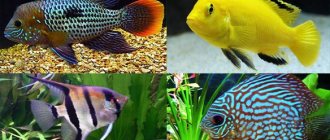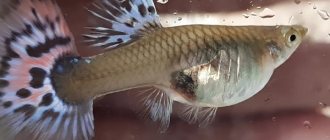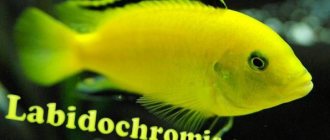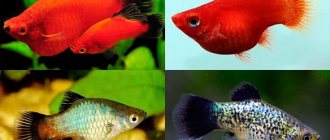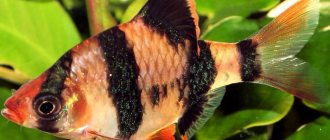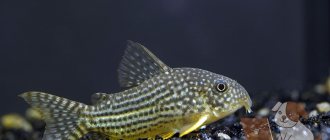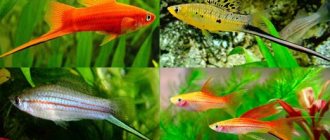Guppy fish are the most popular, picky and common fish among beginner aquarists. With all this, they will be a worthy decoration of the aquarium, since the males have a rather attractive appearance. Their beautiful tail flutters as the fish swims. It looks quite impressive. But the appearance of the female is much more modest. Let's talk about how to distinguish a female guppy from a male and what are the main criteria for differences.
How to tell if a guppy is pregnant
Guppies are viviparous fish with internal fertilization. Sexual maturity in females occurs at 3-4 months. Males begin to court a sexually mature female. After fertilization, the female stops admitting males, and soon the first signs of pregnancy appear.
Many novice aquarists do not know what pregnant guppies look like, and may confuse the fish’s pregnancy with overeating. Determining if a guppy is pregnant is quite simple. The female's abdomen takes on a rounded shape and begins to protrude from the sides. Over time, it becomes rectangular - a “step” appears in front of the anal fin. The head of a pregnant female looks slimmer due to the enlarged belly. When overeating, the fish's belly increases only in the lower part, and its shape remains round.
Another sure sign that the female has become pregnant is the presence of a dark spot in the lower part of the abdomen near the anal fin. At the beginning of the period it is small and implicitly expressed. As the offspring develop, the spot enlarges and becomes darker. However, you should not judge the pregnancy of a guppy by just one spot. In some species it may be absent or subtle, in others it may be present in non-pregnant fish. Therefore, a conclusion about the presence or absence of pregnancy is made based on several signs.
How to determine gender by the structure of the fins?
Another difference between male and female guppies is the structure and shape of their fins. The most noticeable difference is in the structure and shape of the caudal fin. Traditionally, in females it has a simple and round shape. Relative to the body, the fins of females are always proportionally smaller than those of males.
The fins of boy guppies are elongated and elongated. The shape of the caudal fin depends on the breed of fish.
In accordance with this characteristic, it is customary to distinguish between fan-tails, lyre-tails, veil-tails, round-tails, needle-tails, spear-tails, and flag-tails. The anal fin (gonopodium) in males has a phallic shape.
Caring for a pregnant female
A pregnant female guppy needs good care. To ensure that pregnancy and childbirth go smoothly, the following recommendations should be followed:
- The female bearing the fry should be fed variedly. The diet should be complete and contain all the necessary vitamins and nutrients. It is advisable to give live food.
- You should not change water parameters suddenly. This leads to stress and can trigger premature labor.
- There is no need to once again disturb the female who is carrying the fry and transfer her to another aquarium unnecessarily. Any change of environment is stressful for the fish, which can negatively affect the course of pregnancy. It is recommended to remove the female shortly before the onset of birth in order to protect future fry. If the aquarist does not have a goal to get a large offspring, and also if there are a lot of hiding places and few fish in the aquarium, the female can be left to give birth in a general aquarium.
Description
They got their name thanks to their discoverer Robert Guppy in 1866, who discovered them on the island of Trinidad.
They live near the coast in clean waters, but also in brackish ones; they do not like salty sea water. By the way, it is for this reason that the water should not be sea or salty, this is a freshwater fish, maximum salted water.
Guppies are small in nature and are not protected in any way. Males have brighter colors, which at least somehow protect them from predators. The male is smaller than the female, growing about 5 cm in length (males usually grow less in length). There are a huge number of forms and types of guppies, so it is quite problematic to give a clear description of the fish.
Guppies are viviparous (otherwise called viviparous), which means that females give birth to full-fledged fry (the female does not lay eggs). If the fry appears in the egg, it tears it apart.
We talk about reproduction in more detail in another article.
How long does a guppy's pregnancy last?
Guppy pregnancy lasts on average 21-24 days. There are known cases when the duration of gestation was 42 days. The duration of pregnancy is influenced by the following factors:
- age of the fish;
- her state of health;
- stress;
- water temperature;
- conditions of detention;
- feeding.
When the fish is kept in poor conditions, in the presence of stress and inadequate feeding, the gestation period increases. Diseases slow down the development of eggs, and in some cases can cause miscarriages and miscarriages. In young fish, pregnancy lasts longer than in older guppies. A slight increase in water temperature (up to 24-26°C) accelerates the development of eggs. Severe stress can trigger premature birth. Fry born prematurely, as a rule, do not survive.
Feeding
Feeding should be given special attention, since the life and health of pets depends on it. Beginning aquarists are often lost, not knowing what and how often to feed guppies at home. The first thing the owner of these beautiful creatures needs to know is that fish are omnivores and will happily eat everything that is offered to them. However, this does not mean that you can feed the fish with anything - pets require a correct and balanced diet, the basis of which is considered to be live food: daphnia, coretra, bloodworms, tubifex, brine shrimp. Sometimes you can feed your guppies with finely chopped squid fillets. The menu will be complemented by low-fat cottage cheese, omelette, and bread crumbs, which need to be chopped before serving.
The second part of the diet should be plant foods: seaweed, spinach, lettuce and nettle. The greens are first scalded and chopped. It is important to note that plant foods are intended for adult fish only.
How to tell if a female guppy is about to give birth
In the later stages of pregnancy, the female's abdomen becomes rectangular, and the dark spot at the anal fin becomes extensive. It brightens before birth. Through the thin skin of the fish in this area, you can see the outlines of the bodies and eyes of the fry. 1-2 hours before birth, a triangular protrusion forms on the female’s cloaca.
Not only the appearance, but also the behavior of the guppies changes before giving birth. The female loses her appetite, becomes restless, and begins to tremble. She strives to retire and hide from other fish, swimming away into thickets of plants or other shaded places. Guppies often give birth near the bottom or corner of the aquarium, behind a filter or heater. If the surface of the water in the aquarium is covered with floating plants, the fish may choose them as a place to give birth.
Guppy fish diseases: symptoms and their treatment
Guppies are a very hardy fish, however, like all living creatures, they are susceptible to diseases.
Skin and fin fungus
Guppies can be prone to various types of fungal infections. Fungal infection is common among these fish. This is a disease in which small white dots grow on the fish's skin and fins, and you will notice them rubbing against objects.
To get rid of the infection, you can use medications available at your local pet store.
Fin rot
They are also susceptible to fin rot and the tail will appear torn. Again, this can be treated with medication and prevented by choosing suitable companions who will not suppress.
Infertility
Guppies are prone to infertility. Then the fish become unable to reproduce and give birth. You can tell that a fish has become infertile by its color. The color of the fish fades significantly. Also, the red color, which almost every fish of this species has, may simply disappear from the coloration. This disease in fish can occur due to an excess of lighting in the aquarium.
Male underdevelopment
Guppy fish face the problem of poor development of males. It often happens that male fry grow rather poorly and slowly. Even when they finally mature, they may not gain their full height and weight, and their coloring also becomes very faded and sickly.
Hermaphroditism
A common case of hermaphroditism. With this disease, in females not only the ovary develops, but also the testis. The testis is the male reproductive organ of fish. In such cases, the fish is able to fertilize itself and create new offspring.
To reduce the chance of disease entering your aquarium:
- keep water conditions optimal;
- Perform ongoing water changes and maintenance checks;
- always wash everything or quarantine things before adding them to your aquarium;
- keep their stress levels low;
- balanced diet;
- do not overfeed (overfeed).
Also, when fish become ill, obvious symptoms appear. Sometimes you can see with the naked eye that something wrong is happening to the fish. With fungal infections, the owner may notice it. Also, when diseases occur, fish become more lethargic and use less fins. Sometimes they can stop in one place and not move anywhere. Also, the fish may begin to avoid their relatives and hide in thickets or behind decorations.
We hope that the article answered questions regarding keeping Guppy, feeding, reproduction, the difference between a female and a male and possible diseases.
Is it necessary to remove the female for childbirth?
Before giving birth, it is better to remove the female so that the pregnant guppy does not experience stress from the presence of other fish during the process of throwing fry. Removal is also carried out in order to preserve the offspring from being eaten by other inhabitants of the aquarium.
To prevent the guppy from experiencing stress once again, removal is carried out when the fish develops a triangular protrusion in the cloaca area. This sign indicates the imminent (within 1-2 hours) onset of labor.
The fish is moved into a small aquarium (spawning tank) with a volume of 10-15 liters. The water parameters in it should be the same as in the main aquarium. You should not put soil on the bottom - this will keep the water clean longer. It is necessary to place one or several pots with plants in the spawning tank, and also to launch floating greenery - the born fry will hide in it.
On a note! To prevent the female from eating her offspring, just before giving birth, she can be moved to a special small aquarium with holes, which is located in the main spawning area. The holes in its walls do not allow adult fish to escape, but are sufficient for the free passage of fry.
Compatibility with other fish
Guppy fish are very friendly fish and can get along with other fish species in the same aquarium. But their neighbors must also be friendly and peaceful, otherwise the Guppies can easily be eaten or intimidated. Various colorful fish can be excellent neighbors: Norman's blue-eye; Neon; Mollies; Swordtails; Danio; catfish.
Bad neighbors can be: Cichlids; Cockerels (Cockerel may perceive a male Guppy as a male Cockerel and become aggressive).
Guppy fish species
There are quite a large number of species of Guppy fish. Here are the most common Guppies: Fantails; Veil; Voile-scarf; Green; Carpets; Red-tailed Half-black; Round-tailed; Tape; Ribbon-scarf; Semi-black; Mesh; Mesh gold; Smaragdaceae; Emerald gold; Scarf ones.
Postnatal behavior of the female
A female guppy that has given birth can eat the fry, so after the birth process is over, it must be separated from the offspring. If the aquarist is sure that the birth is completely completed, the fish can be returned to the general aquarium. If you suspect that there are fry left inside the female, you can move her to a small hatchery with holes placed inside the spawning tank and leave it for another couple of hours.
After giving birth, the female’s behavior quickly returns to normal: she immediately becomes active, begins to look for food, and after some time she can become pregnant again. After mating with one male, guppies are able to bear offspring up to 8 times in a row, so even if the female is separated from the males, she will still be able to give birth to fry.
Temperature
Experts say that the temperature of the aquarium water is of great importance in determining the life expectancy of domestic guppies. It is known for certain that the higher the temperature, the shorter the guppies will live.
High temperatures shorten the life of pets to 1 year or less. It should be noted that it also negatively affects the appearance of the fish: they become small and grow worse.
Low temperature of aquarium water, on the contrary, helps to increase the life expectancy of fish to 3 years or more. However, there is a very real risk that the guppies may get sick.
The optimal temperature to ensure a comfortable existence for guppies in an aquarium is in the range of +24… +26°. It is highly not recommended to allow these indicators to increase.
Caring for fry in the first days
The fry that are born can be left in the spawning tank. If the number of newborns is large, they should be placed in several aquariums so that they do not lack space. Crowding leads to stunted growth, curvature of the spine and constant fights between fish.
The water in nursery aquariums must be clean. Growing fry quickly pollute it, so once every 1-2 weeks it is necessary to replace 20-40% of the volume. Aquariums should be illuminated 12-15 hours a day. In the first days, you can leave the light on all night. The temperature should be maintained at a constant level, not falling below 23°C. The optimal indicator is 24-25°C.
It is important to ensure good filtration and aeration. Installing a compressor with a sprayer is especially necessary when a large number of fish accumulate in a relatively small volume. If there is a filter, it is covered with tulle so that the fry are not drawn inside.
The fry should be fed several times a day with fine food. In order for the fish to grow well, they should not starve, so food should be in the aquarium almost constantly.
You can use ready-made mixtures to feed the fry, but it is important to avoid overfeeding. Uneaten food quickly spoils the water, and the fish can become poisoned. It is safer to use dried daphnia ground to a dusty state. It floats on the surface of the water for a long time without settling, and it is convenient for guppy fry to collect it. Live dust, rotifers, microworms and Artemia nauplii are used as a source of animal protein.
On a note! To remove excess food, it is advisable to add snails to the aquarium. By disposing of uneaten fish residues, they will help avoid water pollution.
Feeders are not used for newborn fish. The food is scattered evenly over the entire surface area of the water so that none of the fry goes hungry. They begin to accustom fish to the feeder when they are 10-12 days old. At this age, it is already possible to determine the sex of the young: in females, a dark spot appears in the back of the abdomen. To prevent early pregnancy, the fry are seated by gender in separate containers.
Diet and feed quality
Despite the fact that guppies can go without food for a long time, they cannot be forced to starve. In search of food, fish are able to eat all of their offspring.
It is advisable to feed your pets every day, but little by little. Some aquarists give food to their pets twice a day: morning and evening. However, with frequent feeding of the fish, the likelihood increases that part of the food will remain uneaten and will soon begin to decompose. This can negatively affect the purity of the water and the condition of the aquarium ecosystem as a whole. In addition, decomposing food can cause serious illnesses in guppies.
To feed fish, you must use only high-quality products. This can be either dry or live food. According to experienced aquarists, guppies very well accept small live food, which they digest more easily and readily eat. Bloodworms, cyclops, mosquito larvae, daphnia, copepods, and tubifex are usually used as such.
A mixed (combined) type of food is also suitable for guppies. It involves feeding the fish mainly with dry food with periodic transitions to live food.
It is strictly forbidden to feed your fish spoiled or expired food. The fact that the food has become unusable is indicated by the appearance of an unpleasant (usually putrefactive) odor and the formation of a layer of sticky mucus.
Introduction
Guppy fish can confidently be called the most famous aquarium inhabitants. Almost every aquarium starts with these fish, especially if it was originally bought for a child. Guppies are also interesting because they are viviparous fish.
The name of the fish in Latin is Poecilia reticulata. The species received its Russian-language name, which is widely used, from the name of the English scientist and clergyman Robert Guppy. Mr. Guppy discovered these creatures on the island of Triniad, where he collected samples of soil plants. In 1886, the scientist reported about them to the Royal Society, but was ridiculed - the science of those times did not yet know about the ability of fish to give birth to live fry. But to the surprise of pundits, small fish soon appeared in the aquarium of the British Museum, which multiplied from those brought by the priest.
— Advertising —
Guppies appeared in European countries in 1859 - then the German ichthyologist Wilhelm brought them and pointed out their similarity with the Poecilidae family; two years later these creatures were discovered in collections from Barbados. But these discoveries were not known to the general public, so the new species of aquarium inhabitants was given the name Girardinus guppyi.
Under natural conditions, guppies live in rivers and freshwater lakes of the United States, the southern and central parts of the American continent. They live in an aquarium for up to three to four years. The most common fish are blue, gray, silver or white. Dots and specks of different colors may be scattered throughout the body: black, red, yellow, green, blue or with a metallic sheen. Guppies have small rounded fins, colorless and transparent in any color variant.
